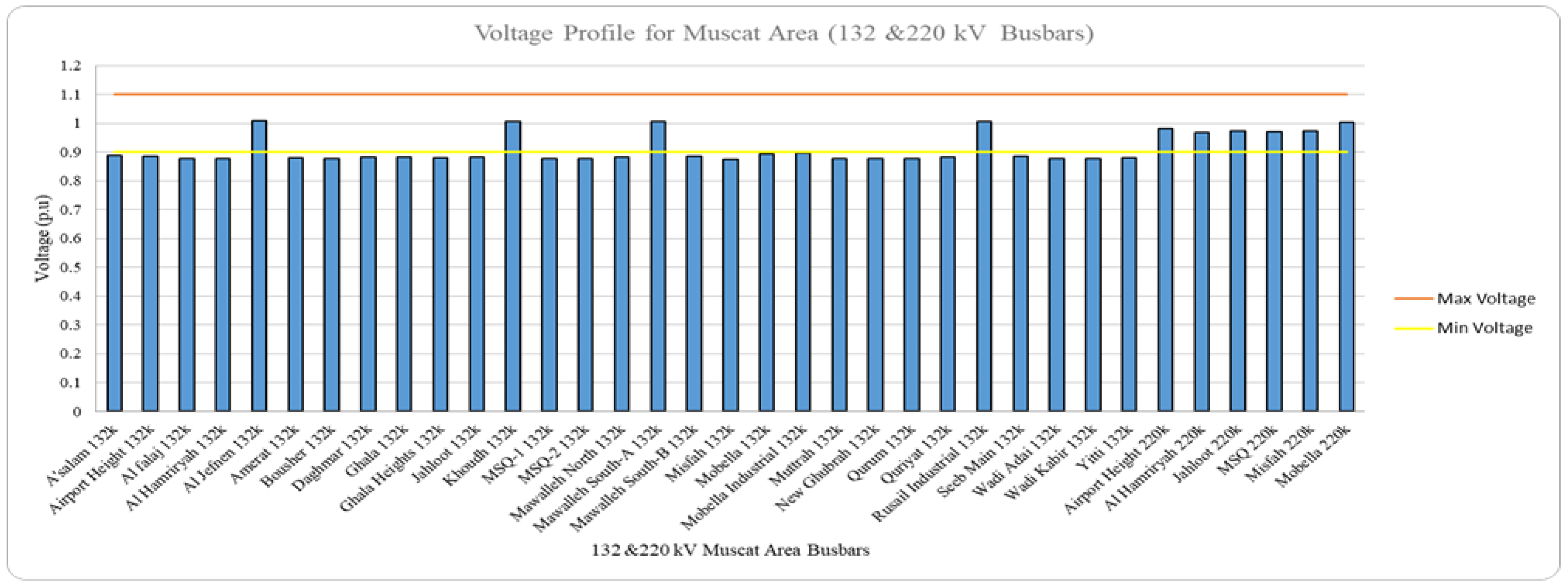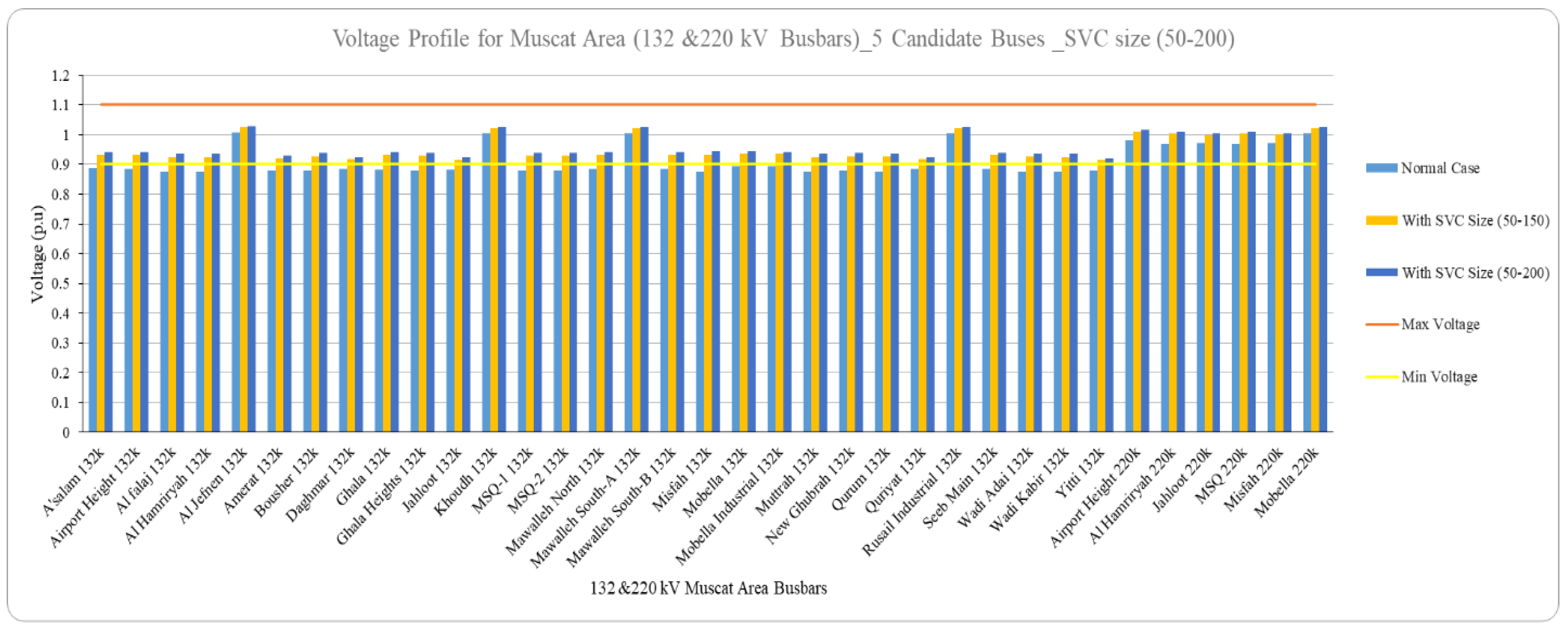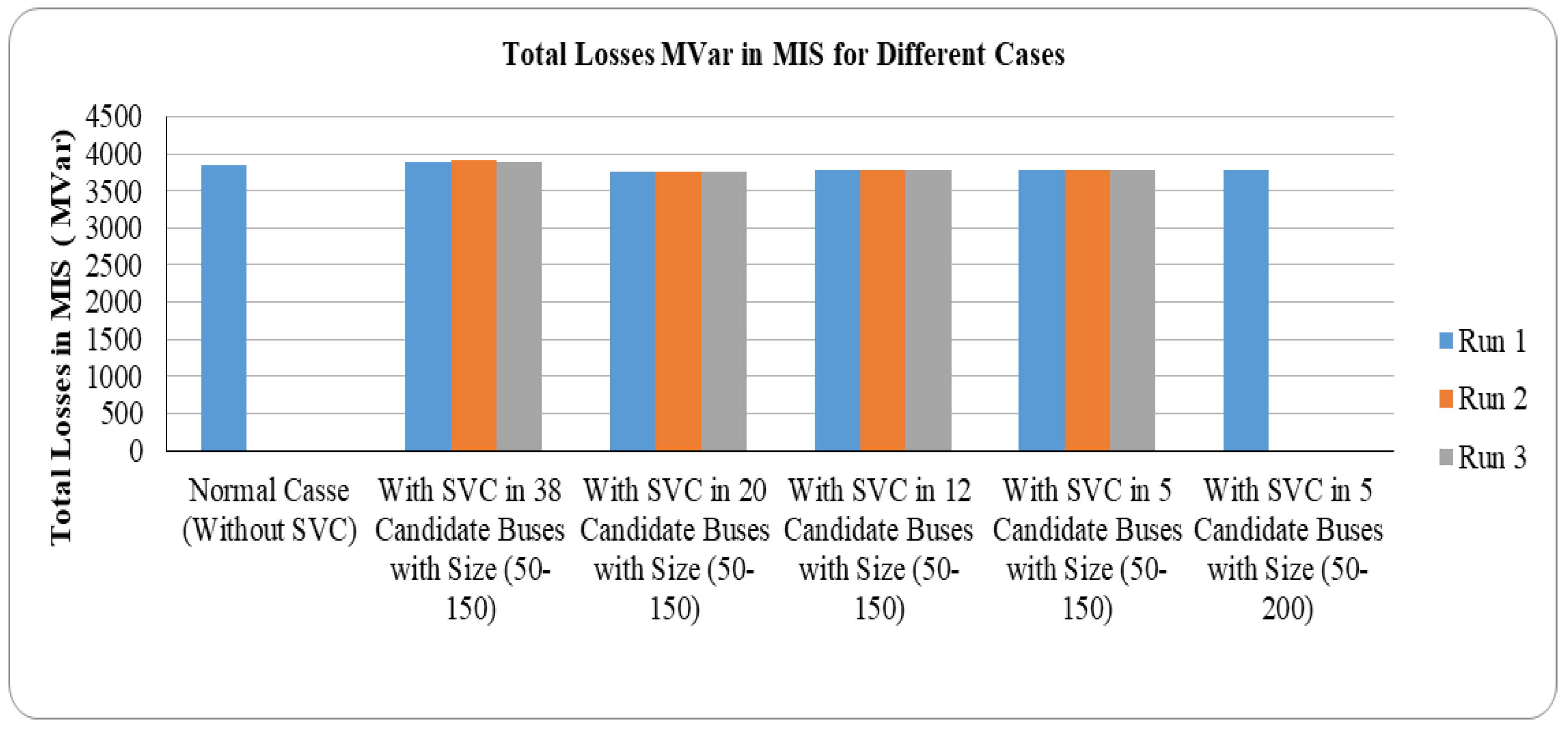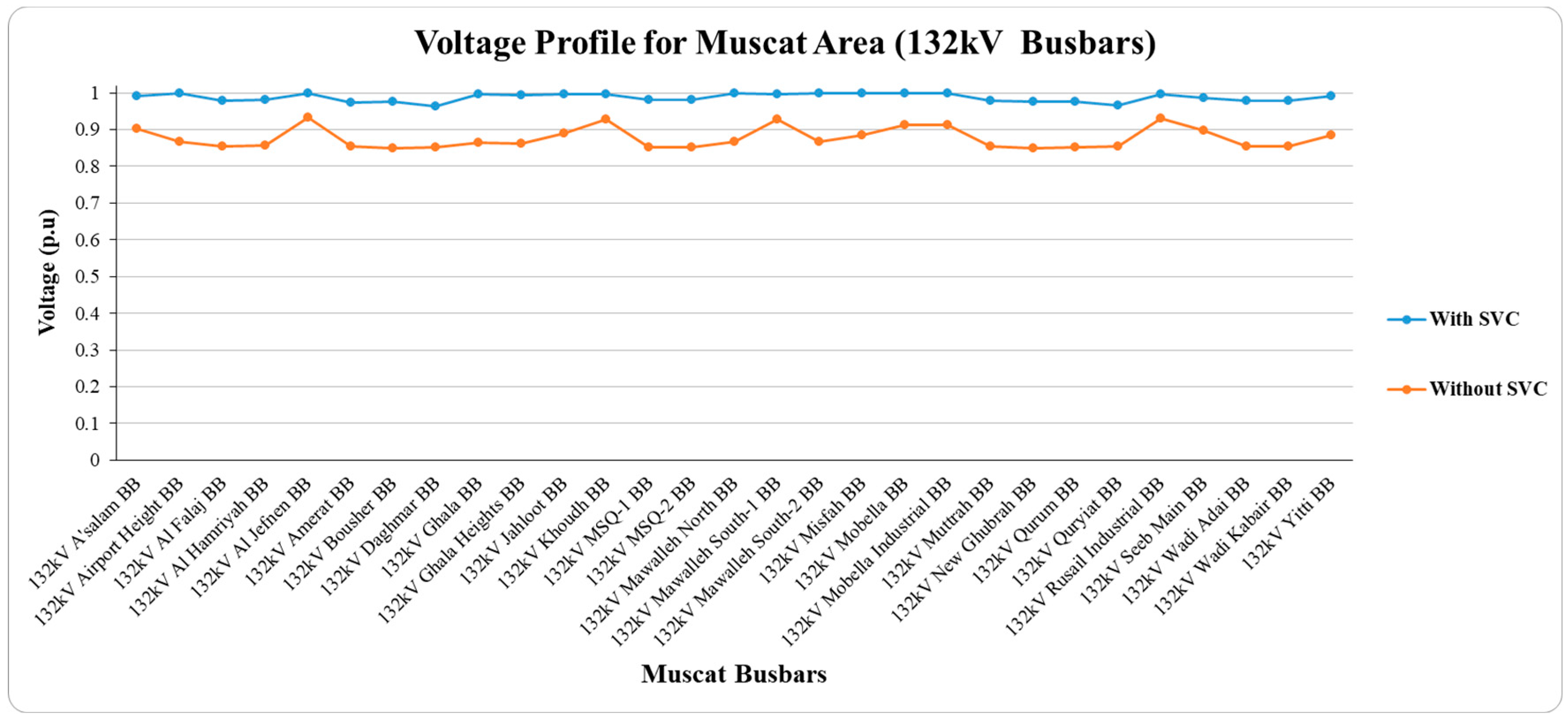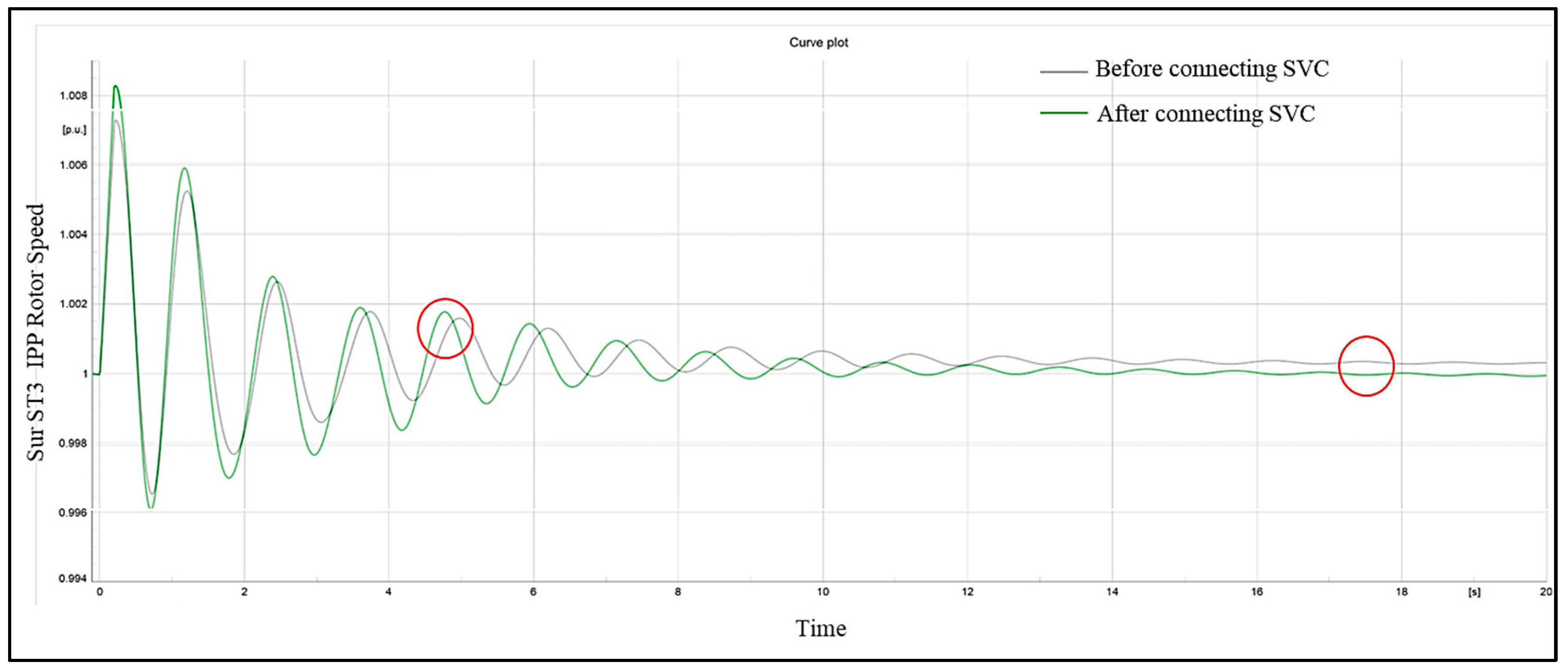1. Introduction
During the last three decades, electricity demand has risen dramatically. However, the generating units’ development has been delayed because of rising energy prices, environmental considerations, right-of-way limitations, and other logistical and financial challenges. As a result, power plants operate at the full capacity of transmission lines (TL) in order to meet electrical demand [
1]. The transmission network connects power plants and load centers to reduce the total power producing capacity and fuel costs [
2]. Therefore, transmission lines are run at maximum capacity near to their thermal limits [
3]. Consequently, electrical utilities are more focused on controlling and regulating the power-flow via the main transmission lines without compromising system reliability as the need for higher electrical energy transfer across existing transmission lines grows. On the other hand, the capacity of transmission lines is limited by some factors. Issues such as transmission network stability, thermal limits, safety, and efficiency may be highlighted as the top restricting factors [
4]. The effect of system stability in terms of voltage or poor voltage regulation is one of the key issues in the transmission system. Controlling reactive power in transmission lines will increase the voltage stability of the power system network [
5]. Utilizing flexible alternating current transmission systems (FACTS) is one of the most popular ways to improve transient stability. FACTS devices are based on power electronics technology, which can control the angle and amplitude of the voltage and current allowing for more flexibility and control of the system operation. The most frequently used FACTS devices are static VAR compensators (SVC) and static synchronous compensators (STATCOM), which control the flow of reactive power in the system and are used to maintain the voltage magnitude at its point of connection [
2,
6,
7]. STATCOM is superior to SVC in terms of a better voltage profile, yet STATCOM is more expensive than SVC in terms of cost [
8,
9,
10,
11,
12,
13]. This work investigated the optimal location, size, and dynamic behavior of SVC.
The power system in Oman is partially integrated. The MIS (main interconnected system), which spans the northern section of the Sultanate, is the main part of the system. Oman Electricity Transmission Company (OETC) is responsible for the transmission system, while Nama Electricity Distribution Company is responsible for the distribution systems [
14]. The main interconnected transmission system (MIS) includes three operating voltages: 400 kV, 220 kV, and 132 kV. The MIS demand is growing yearly, and the generation of utilities should meet the system’s requirements [
14]. Furthermore, OETC plans to install new 400 kV, 220 kV, and 132 kV systems, as well as accompanying grid stations to permit the transfer of energy from centralized power plants and future renewable energy resources. Moreover, large customers with large loads will be directly connected to 220 kV and 132 kV busbars. Therefore, integrating many sources of renewable energy into the system, vast transmission networks, and different demand patterns is affecting the voltage profile of the system. Voltage regulation necessitates careful control of both active and reactive power flows across the transmission system. Regulation of reactive power, which generation units can provide with transformer tap-changers, capacitor banks at 33 kV or below, shunt reactors, series capacitors, or a static var compensator, is required for voltage regulation. OETC has installed shunt reactors on the 400 kV lines to address the overvoltage problem during a light load [
14]. Furthermore, installing SVC in the Muscat area, which represents the largest load area in MIS, will help to maintain the voltage profile for both under and overvoltage problems.
Flexible AC transmission systems (FACTS) are critical for reducing system losses and voltage variations while maximizing transmission line loading. The appropriate size and location determine how much these controllers can enhance transmission network performance. Moreover, FACTS devices are expensive, so optimal sizing is necessary. As a result, the required number and capacity of compensating devices used can reduce the overall cost of the system. However, determining optimal locations and sizes for these devices in massive electrical systems can be challenging because it is a highly nonconvex and nonlinear problem [
1,
2,
3,
4,
5,
6].
In previous research, many different methods and systems were used to define the optimal location and sizes of different FACTS devices [
3,
6,
7]. Some research used analytical approaches to find the optimal locations and settings for FACTS devices such as: using the real power flow performance index in [
8] to find the optimal location and setting of TCSC and UPFC in IEEE-30, a 246-bus practical Indian system and optimal location and setting for TCSC and SSSC in Ref. [
9] in IEEE-30 to improve system security, or the single contingency sensitivity (SCS) index optimal location of TCSC in IEEE-14 and IEEE-118 systems as in reference [
10]. However, analytical approaches offer computational efficiency but may lack accuracy without accounting for the power flow model nonlinearity and the fact that they cannot handle multi-objective optimization, such as FACTS controller placement and settings, simultaneously [
3,
6]. Other research used arithmetic programming approaches such as Ref. [
13] which used mixed integer linear programming (MILP) to define the optimal location, number, and parameter settings of TCSC in the IEEE-9 system. Similarly, Ref. [
15] used the same programming approach to find the optimal location of TCSC in the IEEE-24 system to enhance system loading. Classical optimization techniques have limitations, including the need for complete knowledge of the objective function’s relationship with variables, a propensity for getting stuck in local solutions, and challenges in computing gradients [
3,
6,
11,
12]. On the other hand, most new research used meta-heuristic or artificial intelligence (AI) methods to find the optimal location and size since they are extremely efficient at dealing with multi-model data and discrete, multi-objective, and highly constrained systems [
3,
6,
7,
11,
12,
16,
17,
18,
19]. References [
2,
4,
20,
21,
22] are examples that utilized various AI-based optimization techniques to enhance power system performance through the placement and sizing of FACTS devices. Ref. [
2] employed teaching-learning-based optimization (TLBO) to determine the optimal siting and sizing of SVCs within the IEEE-30 system, with the objective of minimizing real and reactive power loss and voltage deviation. Ref. [
4] employed the grey wolf optimizer to minimize voltage deviation through optimizing the control variables and FACTS device size, encompassing both SVCs and STATCOMs in the IEEE-30 systems. In Ref. [
20], a self-adaptive firefly algorithm was utilized to minimize transmission loss and to identify the location, size, and number of FACTS devices, primarily focused on SVCs in the IEEE-14, IEEE-30, and IEEE-57 systems. Ref. [
21] adopted particle swarm optimization (PSO) to reduce power losses and optimize FACTS device location and size, with a particular emphasis on STATCOMs within the IEEE-14 networks. Finally, Ref. [
22] utilized teaching-learning-based optimization (TLBO) to minimize power losses and offered flexibility in determining the location, size, and type of FACTS devices, serving both SVCs and STATCOMs in the IEEE-14 and IEEE-30 bus systems. These AI-driven approaches provided tailored solutions for improving power system performance, addressing various aspects of system operation, and accommodating a range of system configurations.
Moreover, Ref. [
23] searched for optimal SVC controller parameters; optimum SVC locations were selected based on the effect of load percentage and the line outage on system voltages. In order to reduce network power losses and the cost of installing the FACTS controllers, Ref. [
24] proposed a probabilistic multi-objective optimization approach to determine the ideal sizes and locations of static var compensators (SVCs) and thyristor-controlled series capacitors (TCSCs) in a power transmission network with a high level of wind-generated penetration. In Ref. [
25], a method for selecting the best site for static var compensator (SVC) devices in power systems was presented. This method used a multi-criteria decision-making process called the analytic hierarchy process. A thorough analysis of the available suggestions for improving power system performance through implementing FACTS devices was provided in Ref. [
26].
The comparison of various heuristic optimization techniques revealed that particle swarm optimization (PSO) was a commonly favored method due to its simplicity, low computational time, robustness, and rapid convergence. Research indicated that particle swarm optimization (PSO) was the preferred optimization method, accounting for 45% of applications through optimizing the placement and settings of FACTS devices. Genetic algorithm (GA) followed closely with a 30% usage rate, while the remaining methods collectively represented the remaining 25% [
7,
27]. GA was another popular technique, sharing similarities with PSO although differing in its information exchange mechanisms [
7,
27]. PSO relies on a one-way information exchange system with the global best point distributing information to others, while GA’s chromosomes communicate with each other allowing the entire population to move towards an optimal solution collectively. PSO generally exhibits faster convergence speed compared to GA due to GA’s selection, crossover, and mutation processes. However, PSO can be sensitive to random particle initialization, necessitating multiple trials for reliable results. PSO was also more responsive to parameter changes. Nevertheless, it may suffer from premature convergence and local minima issues in complex optimization problems. GA, on the other hand, tends to be more consistent across multiple trials although it can face challenges with divergence and local optima. These characteristics highlight the trade-offs between PSO and GA in heuristic optimization. Therefore, PSO was used in this research as an optimization method [
27,
28,
29].
However, this previous research worked on small and ideal networks such as IEEE-9, IEEE-14, IEEE-30, IEEE-57, etc. These systems do not implement the real constraints and complexity of the real system. Therefore, this work presents the optimization based on the real system data and a large network (more than 200 buses).
The main contribution of this study can be summarized as follows:
The MIS system was built in MATLAB and DigSILENT environments.
Different steady-state and dynamic scenarios were implemented to see the effect of SVC integration on the MIS in Oman and validated with the Oman grid code.
There was no detailed work related to SVC on the MIS in Oman with multi-objective PSO values presented before.
This work was investigated with the real future years projected data from MIS in Oman to implement SVC in real networks for the future.
